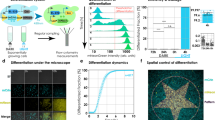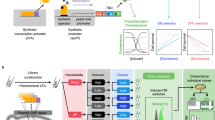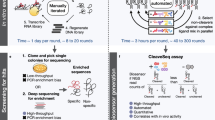Abstract
Precise control over microbial cell growth conditions could enable detection of minute phenotypic changes, which would improve our understanding of how genotypes are shaped by adaptive selection. Although automated cell-culture systems such as bioreactors offer strict control over liquid culture conditions, they often do not scale to high-throughput or require cumbersome redesign to alter growth conditions. We report the design and validation of eVOLVER, a scalable do-it-yourself (DIY) framework, which can be configured to carry out high-throughput growth experiments in molecular evolution, systems biology, and microbiology. High-throughput evolution of yeast populations grown at different densities reveals that eVOLVER can be applied to characterize adaptive niches. Growth selection on a genome-wide yeast knockout library, using temperatures varied over different timescales, finds strains sensitive to temperature changes or frequency of temperature change. Inspired by large-scale integration of electronics and microfluidics, we also demonstrate millifluidic multiplexing modules that enable multiplexed media routing, cleaning, vial-to-vial transfers and automated yeast mating.
This is a preview of subscription content, access via your institution
Access options
Access Nature and 54 other Nature Portfolio journals
Get Nature+, our best-value online-access subscription
$32.99 / 30 days
cancel any time
Subscribe to this journal
Receive 12 print issues and online access
$259.00 per year
only $21.58 per issue
Buy this article
- Purchase on SpringerLink
- Instant access to full article PDF
Prices may be subject to local taxes which are calculated during checkout





Similar content being viewed by others
Accession codes
References
Elena, S.F. & Lenski, R.E. Evolution experiments with microorganisms: the dynamics and genetic bases of adaptation. Nat. Rev. Genet. 4, 457–469 (2003).
Nichols, R.J. et al. Phenotypic landscape of a bacterial cell. Cell 144, 143–156 (2011).
Nevozhay, D., Adams, R.M., Van Itallie, E., Bennett, M.R. & Balázsi, G. Mapping the environmental fitness landscape of a synthetic gene circuit. PLoS Comput. Biol. 8, e1002480 (2012).
Giaever, G. et al. Functional profiling of the Saccharomyces cerevisiae genome. Nature 418, 387–391 (2002).
Li, Z. et al. Systematic exploration of essential yeast gene function with temperature-sensitive mutants. Nat. Biotechnol. 29, 361–367 (2011).
Zuleta, I.A., Aranda-Díaz, A., Li, H. & El-Samad, H. Dynamic characterization of growth and gene expression using high-throughput automated flow cytometry. Nat. Methods 11, 443–448 (2014).
Takahashi, C.N., Miller, A.W., Ekness, F., Dunham, M.J. & Klavins, E. A low cost, customizable turbidostat for use in synthetic circuit characterization. ACS Synth. Biol. 4, 32–38 (2015).
Feist, A.M., Herrgård, M.J., Thiele, I., Reed, J.L. & Palsson, B.Ø. Reconstruction of biochemical networks in microorganisms. Nat. Rev. Microbiol. 7, 129–143 (2009).
Lang, G.I. et al. Pervasive genetic hitchhiking and clonal interference in forty evolving yeast populations. Nature 500, 571–574 (2013).
Maddamsetti, R., Lenski, R.E. & Barrick, J.E. Adaptation, clonal interference, and frequency-dependent interactions in a long-term evolution experiment with Escherichia coli. Genetics 200, 619–631 (2015).
Yona, A.H. et al. Chromosomal duplication is a transient evolutionary solution to stress. Proc. Natl. Acad. Sci. USA 109, 21010–21015 (2012).
Wang, H.H. et al. Programming cells by multiplex genome engineering and accelerated evolution. Nature 460, 894–898 (2009).
Esvelt, K.M., Carlson, J.C. & Liu, D.R. A system for the continuous directed evolution of biomolecules. Nature 472, 499–503 (2011).
Ravikumar, A., Arrieta, A. & Liu, C.C. An orthogonal DNA replication system in yeast. Nat. Chem. Biol. 10, 175–177 (2014).
Crook, N. et al. In vivo continuous evolution of genes and pathways in yeast. Nat. Commun. 7, 13051 (2016).
Bull, A.T. The renaissance of continuous culture in the post-genomics age. J. Ind. Microbiol. Biotechnol. 37, 993–1021 (2010).
Gresham, D. & Dunham, M.J. The enduring utility of continuous culturing in experimental evolution. Genomics 104, 399–405 (2014).
Piper, M.D.W. et al. Reproducibility of oligonucleotide microarray transcriptome analyses. An interlaboratory comparison using chemostat cultures of Saccharomyces cerevisiae. J. Biol. Chem. 277, 37001–37008 (2002).
Cressey, D. The DIY electronics transforming research. Nature 544, 125–126 (2017).
Kong, D.S. et al. Open-source, community-driven microfluidics with Metafluidics. Nat. Biotechnol. 35, 523–529 (2017).
Adamo, A. et al. On-demand continuous-flow production of pharmaceuticals in a compact, reconfigurable system. Science 352, 61–67 (2016).
Perkel, J.M. The Internet of Things comes to the lab. Nature 542, 125–126 (2017).
Toprak, E. et al. Evolutionary paths to antibiotic resistance under dynamically sustained drug selection. Nat. Genet. 44, 101–105 (2012).
Milias-Argeitis, A., Rullan, M., Aoki, S.K., Buchmann, P. & Khammash, M. Automated optogenetic feedback control for precise and robust regulation of gene expression and cell growth. Nat. Commun. 7, 12546 (2016).
Hope, E.A. et al. Experimental Evolution Reveals Favored Adaptive Routes to Cell Aggregation in Yeast. Genetics 206, 1153–1167 (2017).
Toprak, E. et al. Building a morbidostat: an automated continuous-culture device for studying bacterial drug resistance under dynamically sustained drug inhibition. Nat. Protoc. 8, 555–567 (2013).
Thorsen, T., Maerkl, S.J. & Quake, S.R. Microfluidic large-scale integration. Science 298, 580–584 (2002).
Melin, J. & Quake, S.R. Microfluidic large-scale integration: the evolution of design rules for biological automation. Annu. Rev. Biophys. Biomol. Struct. 36, 213–231 (2007).
Unger, M.A., Chou, H.P., Thorsen, T., Scherer, A. & Quake, S.R. Monolithic microfabricated valves and pumps by multilayer soft lithography. Science 288, 113–116 (2000).
Grover, W.H., Skelley, A.M., Liu, C.N., Lagally, E.T. & Mathies, R.A. Monolithic membrane valves and diaphragm pumps for practical large-scale integration into glass microfluidic devices. Sens. Actuators B Chem. 89, 315–323 (2003).
Kryazhimskiy, S., Rice, D.P., Jerison, E.R. & Desai, M.M. Microbial evolution. Global epistasis makes adaptation predictable despite sequence-level stochasticity. Science 344, 1519–1522 (2014).
Mitchell, A. et al. Adaptive prediction of environmental changes by microorganisms. Nature 460, 220–224 (2009).
Ketola, T. et al. Fluctuating temperature leads to evolution of thermal generalism and preadaptation to novel environments. Evolution 67, 2936–2944 (2013).
Sæther, B.-E. & Engen, S. The concept of fitness in fluctuating environments. Trends Ecol. Evol. 30, 273–281 (2015).
Bennett, M.R. et al. Metabolic gene regulation in a dynamically changing environment. Nature 454, 1119–1122 (2008).
Salignon, J., Richard, M., Fulcrand, E. & Yvert, G. Genomics of cellular proliferation in periodic environmental fluctuations. Mol. Syst. Biol. 14, e7823 (2018).
Giaever, G. & Nislow, C. The yeast deletion collection: a decade of functional genomics. Genetics 197, 451–465 (2014).
Smith, A.M. et al. Quantitative phenotyping via deep barcode sequencing. Genome Res. 19, 1836–1842 (2009).
Gibney, P.A., Lu, C., Caudy, A.A., Hess, D.C. & Botstein, D. Yeast metabolic and signaling genes are required for heat-shock survival and have little overlap with the heat-induced genes. Proc. Natl. Acad. Sci. USA 110, E4393–E4402 (2013).
Cherry, J.M. et al. Saccharomyces Genome Database: the genomics resource of budding yeast. Nucleic Acids Res. 40, D700–D705 (2012).
Morano, K.A., Grant, C.M. & Moye-Rowley, W.S. The response to heat shock and oxidative stress in Saccharomyces cerevisiae. Genetics 190, 1157–1195 (2012).
Loar, J.W. et al. Genetic and biochemical interactions among Yar1, Ltv1 and Rps3 define novel links between environmental stress and ribosome biogenesis in Saccharomyces cerevisiae. Genetics 168, 1877–1889 (2004).
Escalante-Chong, R. et al. Galactose metabolic genes in yeast respond to a ratio of galactose and glucose. Proc. Natl. Acad. Sci. USA 112, 1636–1641 (2015).
Rice, S.A. et al. Biofilm formation and sloughing in Serratia marcescens are controlled by quorum sensing and nutrient cues. J. Bacteriol. 187, 3477–3485 (2005).
Anderson, J.B., Sirjusingh, C. & Ricker, N. Haploidy, diploidy and evolution of antifungal drug resistance in Saccharomyces cerevisiae. Genetics 168, 1915–1923 (2004).
González, C. et al. Stress-response balance drives the evolution of a network module and its host genome. Mol. Syst. Biol. 11, 827 (2015).
Brauer, M.J., Saldanha, A.J., Dolinski, K. & Botstein, D. Homeostatic adjustment and metabolic remodeling in glucose-limited yeast cultures. Mol. Biol. Cell 16, 2503–2517 (2005).
Alper, H., Fischer, C., Nevoigt, E. & Stephanopoulos, G. Tuning genetic control through promoter engineering. Proc. Natl. Acad. Sci. USA 102, 12678–12683 (2005).
Hutchison, C.A. III et al. Design and synthesis of a minimal bacterial genome. Science 351, aad6253–aad6253 (2016).
Richardson, S.M. et al. Design of a synthetic yeast genome. Science 355, 1040–1044 (2017).
Acknowledgements
We are grateful to B. Stafford for his assistance in design architecture of the system. We thank H. Khalil, A. Soltanianzadeh, A. Sun, S. Pipe, and A. Cavale for help on construction of the system. We are indebted to the Electronics Design Facility (EDF) and Engineering Product Innovation Center (EPIC) at Boston University for their services. We also thank D. Segrè, J. Ngo, J. Tytell, W. Wong, and members of the Khalil lab for insightful comments on the manuscript. This work was supported by a NSF CAREER Award (MCB-1350949 to A.S.K.) and a DARPA grant (HR0011-15-C-0091 to A.S.K.). A.S.K. also acknowledges funding from the NIH Director's New Innovator Award (1DP2AI131083-01), DARPA Young Faculty Award (D16AP00142), and NSF Expeditions in Computing (CCF-1522074).
Author information
Authors and Affiliations
Contributions
B.G.W., C.J.B., and A.S.K. conceived the study. B.G.W. developed the system with guidance and input from all authors. B.G.W. and C.P.M. performed and analyzed experiments. S.K. generated reagents. C.J.B. and A.S.K. oversaw the study. All authors wrote the paper.
Corresponding authors
Ethics declarations
Competing interests
The authors declare no competing financial interests.
Supplementary information
Supplementary Text and Figures
Supplementary Figures 1–37, Supplementary Notes 1–17, Supplementary Tables 1–3 (PDF 13265 kb)
Supplementary Code
Supplementary Code (ZIP 2103 kb)
Rights and permissions
About this article
Cite this article
Wong, B., Mancuso, C., Kiriakov, S. et al. Precise, automated control of conditions for high-throughput growth of yeast and bacteria with eVOLVER. Nat Biotechnol 36, 614–623 (2018). https://doi.org/10.1038/nbt.4151
Received:
Accepted:
Published:
Issue date:
DOI: https://doi.org/10.1038/nbt.4151
This article is cited by
-
From beer to breadboards: yeast as a force for biological innovation
Genome Biology (2024)
-
Mammalian cell growth characterisation by a non-invasive plate reader assay
Nature Communications (2024)
-
Highly parallelized laboratory evolution of wine yeasts for enhanced metabolic phenotypes
Molecular Systems Biology (2024)
-
Multi-Attribute Subset Selection enables prediction of representative phenotypes across microbial populations
Communications Biology (2024)
-
Microfluidics for adaptation of microorganisms to stress: design and application
Applied Microbiology and Biotechnology (2024)



